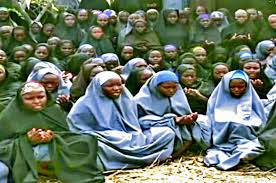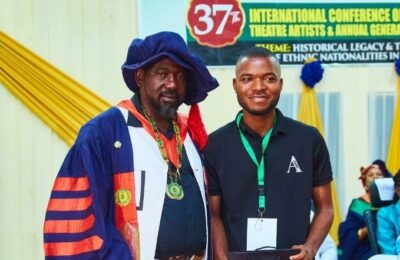On the night of 14–15 April 2014, 276 mostly Christian female students aged from 16 to 18 were kidnapped by the islamic terrorist group boko haram from the Government Girls Secondary School at the town of Chibok in Borno state, Nigeria.
Prior to the raid, the school had been closed for four weeks due to deteriorating security conditions, but the girls were in attendance in order to take final exams in physics.
57 of the schoolgirls escaped immediately following the incident by jumping from the trucks on which they were being transported, and others have been rescued by the Nigerian armed forces on various occasions.
Hopes have been raised that the 219 remaining girls might be released, however some girls are believed to be dead.
Amina Ali, one of the missing girls, was found in May 2016. She claimed that the remaining girls were still there, but that six had died.
As of 14 April 2021, seven years after the initial kidnapping, over 100 of the girls remain missing.
Some have described their capture in appearances at international human rights conferences.
Boko Haram has used the girls as negotiating pawns in prisoner exchange offering to release some girls in exchange for some of their captured commanders in jail.
The girls kidnapped in Chibok in 2014 are only a small percentage of the total number of people abducted by Boko Haram.
Amnesty International estimated in 2015 that at least 2,000 women and girls had been abducted by the group since 2014, many of whom had been forced into sexual slavery.
Proun nourry in collaboration with 108 students of Obafemi Awolowo University and the family of the abducted girls, produced 108 clay-head sculptures of the missing girls.
The overwhelming majority of the kidnapped girls who were Christian were forced to convert to Islam.The girls were forced into marriage with members of Boko Haram, with a reputed bride price of 2000 naira each.
Sightings of the students were reported by villagers living in the sambisa forest considered a refuge for Boko Haram. Others reported seeing the students crossing into the neighbouring countries of Chad and Cameroon with the militants, though Kashim Shettima the then Governor of Borno State in Nigeria, said on 11 May that he had sighted the abducted girls and claimed that they had not been taken across the borders into either country.
The Nigerian Military enlisted help from local volunteers and vigilante in order to search forests close to Nigeria’s borders by 21 April local residents were able to track the movements of the students with the help of contacts across north eastern Nigeria.
A diary written by some of the kidnapped students described how some were able to escape, but were returned to Boko Haram by local villagers and whipped as punishment.
On 2 May, the Nigerian police said that the exact number of students kidnapped was unclear and asked parents to forward the names and photos of kidnapped girls so an official count could be made.
The police blamed damage to school records during the attack as a reason for the confusion.
Nigerian President Goodluck Jonathan spoke publicly about the kidnapping for the first time on 4 May, saying the government was doing everything it could to find the missing girls.
At the same time, he criticized parents for not supplying enough information about their missing children, claiming that they were not fully cooperating with the police.
The Guardian reported that the British Royal Air force conducted Operation Turus in response to the kidnapping. A source involved with the operation told the Observer that “the girls were located in the first few weeks of the RAF mission”, and that “we (RAF) offered to rescue them, but the Nigerian government declined”, because they viewed the matter as a “national issue” to be resolved by Nigerian intelligence and security services. Sir Andrew pocock British High commissioner to Nigeria at the time of the kidnapping, said that a couple of months after the kidnapping, a group of up to 80 of the Chibok girls were seen by American “eye in the sky” technology but nothing was done. About 80 girls, a camp and evidence of vehicle movement were spotted next to a local landmark called the “Tree of Life” in the Sambisa forest.
Boko Haram leader Abubakar shekau claimed responsibility for the kidnappings in a video released shortly after 1pm on 5 May.Shekau claimed that “Allah instructed me to sell them… I will carry out his instruction and that slavery is allowed in my religion and I shall capture people and make them slaves.
He said the girls should not have been in school and instead should have been married since girls as young as nine are suitable for marriage.
Another video was released a week later, which showed about 130 girls dressed in hijabs and long Islamic chardos.This was the first public sighting of the girls since they were abducted from Chibok.
In this video, Shekau acknowledged that many of the girls were not Muslims, but that some had converted to Islam and that they would “treat them well the way the Prophet Muhammed treated the infidels he seized.
Shekau also mentioned that he would not release the girls until captured Boko Haram militants in prison were released, raising the possibility of a prisoner exchange with the Nigerian government.
Following the Chibok kidnapping, several attacks linked to Boko Haram occurred in Nigeria. On 5 May, at least 300 residents of the nearby town of Gamboru Ngala were killed in an attack by Boko Haram militants after Nigerian security forces left the town to search for the kidnapped students.
The next day, Boko Haram militants abducted 8 girls aged between 12 and 15 from northeastern Nigeria.
In the night of 13 to 14 May, Boko Haram ambushed a military convoy that was searching for the abductees near Chibok, killing twelve soldiers and wounding several others. The incident led to mutiny of government forces at Maiduguri reducing the ability of the Nigerian Army to rescue the schoolgirls. Between 20 and 23 June, 91 women and children were abducted in other area of borno state by Boko Haram militants, with an estimated 600 girls held by Boko Haram in three camps outside Nigeria by this stage.
Boko Haram once again attacked Chibok and other nearby villages on 22 July, killing at least 51 people, including 11 parents of the abducted girls.
A journalist-brokered deal to secure the release of the girls in exchange for 100 Boko Haram prisoners held in Nigerian jails was scrapped at a late stage on 24 May after President Goodluck Jonathan consulted with U.S., Israeli, French and British foreign ministers in Paris, where the consensus was that no deals should be struck with terrorists, and that a solution involving force was required.
On 26 May, the Nigerian Chief of Defence Staff announced that the Nigerian security forces had located the kidnapped girls, but ruled out a forceful rescue attempt for fears of collateral damage.
Two of the kidnapped girls were found raped, “half-dead”, and tied to a tree on 30 May by a civilian militia in the Baale region of Northeastern Nigeria.
Villagers said that Boko Haram had left the two girls and had killed four other disobedient girls and buried them.
Another 4 girls escaped later in the year, walking for three weeks and reaching safety by 12 October. They said they had been held in a camp in Cameroon and raped every day.
It was reported on 26 June that the Nigerian government had signed a contract worth more than $1.2 million with Levick, a Washington D.C public relations firm to work on “the international and local media narrative” surrounding the Chibok schoolgirl kidnapping.
The contract was labeled a waste of money by President Jonathan’s critics.
Jonathan was criticized for a lack of communication regarding the kidnapping, but he later attributed his silence to a desire not to compromise the details of security efforts being carried out to rescue the girls via a column the Washington Post.
On 1 July, a businessman suspected of carrying out the kidnappings of the school girls, as well as the bombing of a busy market in northeastern Nigeria, was arrested. Military sources said that he was also accused of helping the Islamist militant group kill the traditional leader Idrissa Timta the Emir of Gwoza.
Two weeks later, Zakaria Mohammed, a high-ranking member of Boko Haram was arrested at Darazo-Basrika Road while fleeing from counterinsurgency operations around the Balmo Forest.
Events in 2015
Stephen Davis, a former Anglican clergyman contacted three Boko Haram commanders who said they might be prepared to release Chibok schoolgirls and went to Nigeria in April 2015. He was given proof of life (a video of them being raped) and was told 18 were seriously ill, some with HIV. Davis got initial agreement that Boko Haram would release these ill girls. However, after three attempts the deal fell through when another group abducted the girls believing they could make money out of them and Davis left Nigeria.Davis commented that it was not difficult to locate the five or six main Boko Haram camps, and that he was able to find them on Google Earth
Renovation of the school commenced in March, with Nigerian finance minister Ngozi Okonjo Iweala visiting Chibok to deliver a short speech and help with Laying bricks at the school.
By May, the Nigerian military had reclaimed most of the areas previously controlled by Boko Haram in Nigeria including many of the camps in the Sambisa forest where it was suspected the Chibok girls had been kept.
Although many women previously held captive by Boko Haram had been freed as the Nigerian military reclaimed these areas, none of the Chibok girls were found.
President Muhammadu Buhari who gained power through the 2015 Nigerian General Election stated in December that he was willing to negotiate with Boko Haram for the release of the Chibok girls without any preconditions.
Acting director of defence information, Col. Rabe Abubakar, stated that the Nigerian armed forced would “not rush” to rescue the remaining girls. He justified this by claiming that rescue operations required “diligent intervention and a high-level operation.
– Aminu Dauda Uchene
Student in the Department of Mass Communication
Prince Abubakar Audu University Anyigba, Kogi State.




